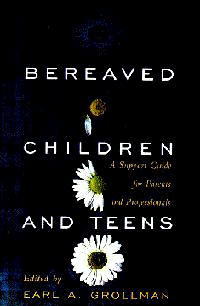 by Earl A. Grollman
by Earl A. Grollman
This resource is a comprehensive guide to helping children and adolescents cope with the emotional, religious, social, and physical consequences of a loved one's death.
Full Description:
This comprehensive guide to help children and adolescents cope with the emotional, religious, social, and physical consequences of a loved one's death. Topics covered include what to say and what not to say when explaining death to very young children; how teenagers grieve differently from children and adults; how to translate Protestant, Catholic, or Jewish beliefs about death into language that children can understand; how ethnic and cultural differences can affect how children grieve; what teachers and parents can do to help bereaved young people at school; and activities, books, and films that help children and teens cope. Chapter ExceptAdolescent Understandings of Death Understanding the Concept as Opposed to the Significance of DeathSome children may not be able to understand the concept of death or may be able to understand only some aspects of that concept (e.g., its finality but not its universality). Normally developing adolescents, however, are capable of understanding the concept of death in mature or adult ways. This statement may seem to imply that the major transition in developing understandings of death is between the cognitive capacities of childhood and those of adolescence. Were this true, the only important factor would be the capacity to think in an abstract way, and there would be no essential differences between the ways in which adolescents and adults can or do think about death. In fact, that is not correct. Normally developing adolescents can think about death in a abstract, conceptual, formal, mature, scientific, or adult way. That fact on its own does not necessarily mean that they actually or even frequently do think about death in those ways. To have the ability to think in a certain way is not the same as actually thinking in that way. The import of this can be illustrated in various ways. For example, in one research study (Alexander and Adlerstein 1958), 108 boys between the ages of five and sixteen years were asked to engage in a word association test in which three death-related words (buried, kill, and dead) were included in a set of twenty-seven stimulus words. Decreased speed of response and decreased galvanic skin resistance (associated with increased perspiration) were interpreted as reflecting heightened anxiety. Scoring results displayed a bimodal distribution. Those who were five to eight years old and thirteen to sixteen years old had higher scores than those who were nine to twelve years old. On the surface, this is somewhat surprising. One might have expected increasing conceptual awareness of death to be either directly or inversely associated with anxiety about death. That is, greater understanding might have led to lessened anxiety because of the element of increased personal control implied in the ability to form and work with abstract concepts. Alternatively, greater understanding might have led to heightened anxiety because of increasing awareness of the finality and universality implicit in the content of one's concept of death. In fact, the researchers concluded that "death has a greater emotional significance for people with less stable ego self-pictures than for people with an adequate concept of the self" (Alexander and Adlerstein 1958, 157). This is relevant both to children who are five to eight years old and confronting challenges in their early school years and to adolescents for whom, as we have seen, ego stability and identity are precisely the central developmental issues. In other words, that an adolescent is able to understand or actually does understand that all human beings are mortal is not the same as the realization that the attribute of mortality applies to himself or herself. Thus, Tolstoy (1884/1960, 131) wrote the following about Ivan Ilych: "The syllogism he had learnt from Kiezewetter's Logic: 'Caius is a man, men are mortal, therfore Caius is mortal' had always seemed to him correct as applied to Caius, but certainly not as applied to himself." Instead of grasping the personal significance of mortality, the adolescent Ivan was content merely to note that the abstract concept mortality was somehow joined or linked to the equally abstract of distanced notion Caius (or, perhaps, humanity). For Ivan Ilych, it took a life-threatening event and the experience of his own dying to break through this distanced and abstract concatenation of concepts. What would it take for an adolescent in our society to grasp the implications of his or her own personal mortality?
256 pages; 5 X 9;soft bound
PART ONE: Death, Development, and Relationships - Explainging Death to Young Children: Some Questions and Answers
- Entering into Adolescent Understandings of Death
- Friends, Teachers, Movie Stars: The disenfranchised Grief of Children
- Talking to Children about the Terminal Illness of a Loved One
- Toward Siblings' Understanding and Perspectives of Death
PART TWO: Cultural, Philosophical, and Religious Perspectives on Death and Children - Children and Death: Diversity in Universality
- Behind Smiles and Laughter: African-American Children's Issues about Bereavement
- Protestant Perspectives on Grief and Children
- Life, Death, and the Catholic Child
- Explaining Death to Children from Jewish Perspectives
- A Philosopher looks at Children and Death
PART THREE: Treatments and Therapies That Can Help Children Cope with Death - Care of the Dying Child
- "I Thought about Death All the Time...":
- Students, Teachers, and the Understanding of Death
- Special Needs of Bereaved Children: Effective Tools for Helping
- Using Story, Film, and Drama to Help Children Cope with Death
In-Stock- Orders received before 4pm EST will be shipped the same business day!
|